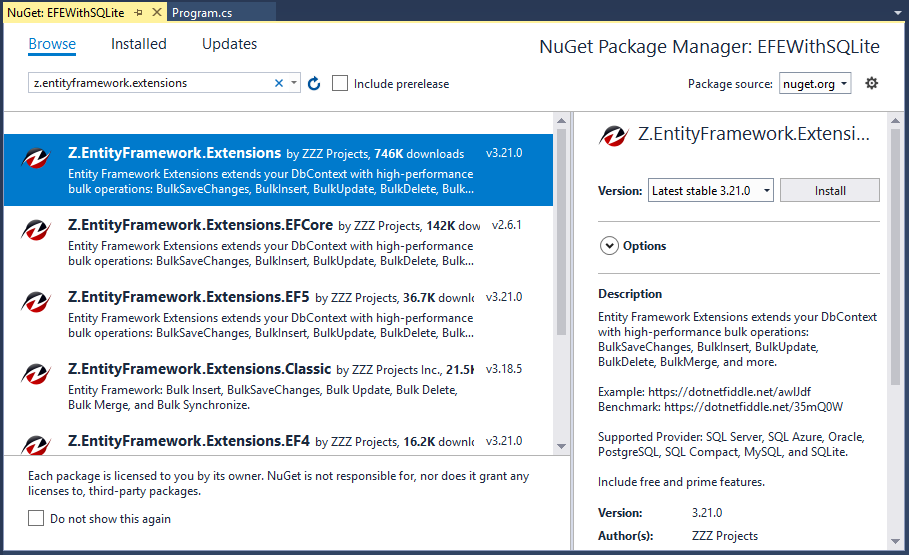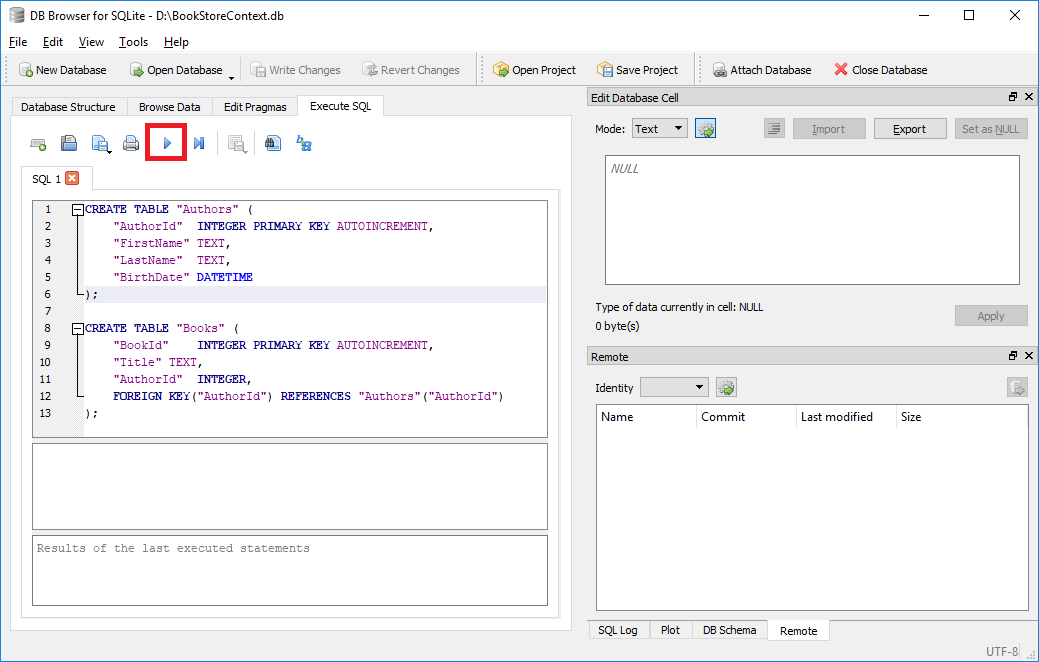EF6 - SQLite Provider
SQLite is a software library that implements a self-contained, serverless, zero-configuration, transactional SQL database engine.
- It is the most widely deployed SQL database engine and the source code for SQLite is in the public domain.
- It is a database, which does not need to be configured in your system like other databases.
Install EFE
Let's create a new application using the Console App (.NET Framework) template and install Z.EntityFramework.Extensions.
Entity Framework Extensions (EFE) library is available as a NuGet package and you can install it using NuGet Package Manager.
In the Package Manager Console window, enter the following command.
PM> Install-Package Z.EntityFramework.Extensions
You can also install EFE by right-clicking on your project in Solution Explorer and selecting Manage NuGet Packages....

Search for Z.EntityFramework.Extensions and install the latest version by pressing the install button.
Register EF Provider
EF providers can be registered using either code-based configuration or in the application's config file. Install the System.Data.SQLite NuGet package to add this reference automatically within app.config or web.config file during the installation.
PM> Install-Package System.Data.SQLite
Let's open the App.config file.
<?xml version="1.0" encoding="utf-8"?> <configuration> <configSections> <section name="entityFramework" type="System.Data.Entity.Internal.ConfigFile.EntityFrameworkSection, EntityFramework, Version=6.0.0.0, Culture=neutral, PublicKeyToken=b77a5c561934e089" requirePermission="false" /> <!-- For more information on Entity Framework configuration, visit https://go.microsoft.com/fwlink/?LinkID=237468 --> </configSections> <startup> <supportedRuntime version="v4.0" sku=".NETFramework,Version=v4.7.2" /> </startup> <entityFramework> <defaultConnectionFactory type="System.Data.Entity.Infrastructure.SqlConnectionFactory, EntityFramework" /> <providers> <provider invariantName="System.Data.SqlClient" type="System.Data.Entity.SqlServer.SqlProviderServices, EntityFramework.SqlServer" /> <provider invariantName="System.Data.SQLite.EF6" type="System.Data.SQLite.EF6.SQLiteProviderServices, System.Data.SQLite.EF6" /> </providers> </entityFramework> <system.data> <DbProviderFactories> <remove invariant="System.Data.SQLite.EF6" /> <add name="SQLite Data Provider (Entity Framework 6)" invariant="System.Data.SQLite.EF6" description=".NET Framework Data Provider for SQLite (Entity Framework 6)" type="System.Data.SQLite.EF6.SQLiteProviderFactory, System.Data.SQLite.EF6" /> <remove invariant="System.Data.SQLite" /><add name="SQLite Data Provider" invariant="System.Data.SQLite" description=".NET Framework Data Provider for SQLite" type="System.Data.SQLite.SQLiteFactory, System.Data.SQLite" /></DbProviderFactories> </system.data> </configuration>
Note that often if the EF provider is installed from NuGet, then the NuGet package will automatically add this registration to the config file.
- The invariantName in this registration is the same invariant name used to identify an ADO.NET provider. Let's change the invariant name
System.Data.SQLite.EF6toSystem.Data.SQLite. - The type in this registration is the assembly-qualified name of the provider type that derives from
System.Data.SQLite.EF6.SQLiteProviderServices.
You are now ready to start your application.
Create SQLite Database
Unlike MS SQL Server, Sqlite doesn't support Migration so we can't create a new database from code, we have to manually create it.
- You can use any tool you have to create an SQLite database.
- Here we will be using DB Browser for SQLite, it's easy to install, easy to use and very stable.
After installing this tool, create a new database and then go to the Execute SQL tab to add tables using the following SQL statements.
CREATE TABLE "Authors" ( "AuthorId" INTEGER PRIMARY KEY AUTOINCREMENT, "FirstName" TEXT, "LastName" TEXT, "BirthDate" DATETIME ); CREATE TABLE "Books" ( "BookId" INTEGER PRIMARY KEY AUTOINCREMENT, "Title" TEXT, "AuthorId" INTEGER, FOREIGN KEY("AuthorId") REFERENCES "Authors"("AuthorId") );
 Click on the highlighted button to create `Authors` and `Books` tables. It is not Code First because we have to create the database ourselves but we want to illustrate how Entity Framework for SQLite works.
## Create Data Model
The model is a collection of classes to interact with the database.
Click on the highlighted button to create `Authors` and `Books` tables. It is not Code First because we have to create the database ourselves but we want to illustrate how Entity Framework for SQLite works.
## Create Data Model
The model is a collection of classes to interact with the database.
- A model stores data that is retrieved according to the commands from the Controller and displayed in the View.
- It can also be used to manipulate the data to implement the business logic.
To create a data model for our application, we will start with the following two entities.
public class Author { public int AuthorId { get; set; } public string FirstName { get; set; } public string LastName { get; set; } public DateTime BirthDate { get; set; } public List<Book> Books { get; set; } } public class Book { public int BookId { get; set; } public string Title { get; set; } [ForeignKey("Author")] public int AuthorId { get; set; } public Author Author { get; set; } }
There's a one-to-many relationship between Author and Book entities. In other words, an author can write any number of books, and a book can be written by only one author.
Create Database Context
The database context class provides the main functionality to coordinate Entity Framework with a given data model.
- You create this class by deriving from the
System.Data.Entity.DbContextclass. - In your code, you specify which entities are included in the data model.
- You can also customize certain Entity Framework behaviors.
So, let's add a new BookStore class which will inherit the DbContext class.
public class BookStore : DbContext { public BookStore() : base("BookStoreContext") { } public DbSet<Author> Authors { get; set; } public DbSet<Book> Books { get; set; } }
This code creates a DbSet property for each entity set. In Entity Framework terminology, an entity set typically corresponds to a database table, and an entity corresponds to a row in the table.
Setup Database
The name of the connection string is passed into the constructor of the context class.
public BookStore() : base("BookStoreContext") { }
Connection String
Let's open the application App.config file and add a connectionStrings element.
<connectionStrings> <add name="BookStoreContext" connectionString="Data Source=D:\BookStoreContext.db;Version=3" providerName="System.Data.SQLite" /> </connectionStrings>
The above connection string specifies that Entity Framework will use a BookStoreContext.db database located on D drive which we have created earlier.
Now, we are done with the required classes, so let's add some authors and books records to the database and then retrieve it.
using (var context = new BookStore()) { context.Database.Delete(); var authors = new List<Author> { new Author { FirstName ="Carson", LastName ="Alexander", BirthDate = DateTime.Parse("1985-09-01"), Books = new List<Book>() { new Book { Title = "Introduction to Machine Learning"}, new Book { Title = "Advanced Topics in Machine Learning"}, new Book { Title = "Introduction to Computing"} } }, new Author { FirstName ="Meredith", LastName ="Alonso", BirthDate = DateTime.Parse("1970-09-01"), Books = new List<Book>() { new Book { Title = "Introduction to Microeconomics"} } }, new Author { FirstName ="Arturo", LastName ="Anand", BirthDate = DateTime.Parse("1963-09-01"), Books = new List<Book>() { new Book { Title = "Calculus I"}, new Book { Title = "Calculus II"} } } }; //IncludeGraph allows you to INSERT/UPDATE/MERGE entities by including the child entities graph. context.BulkInsert(authors, options => options.IncludeGraph = true ); } using (var context = new BookStore()) { var list = context.Authors .Include(a => a.Books) .ToList(); foreach (var author in list) { Console.WriteLine(author.FirstName + " " + author.LastName); foreach (var book in author.Books) { Console.WriteLine("\t" + book.Title); } } }
If you run the application, you will see that authors and books are successfully inserted into the database.
ZZZ Projects